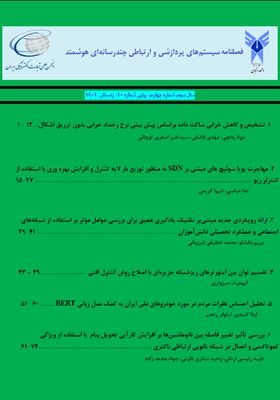تقسیم توان بین اینورترهای ریزشبکه جزیرهای با اصلاح روش کنترل افتی
محورهای موضوعی : پردازش چند رسانه ای، سیستمهای ارتباطی، سیستمهای هوشمند
1 - استادیار، گروه مهندسی برق، دانشگاه فنی و حرفهای، تهران، ایران
کلید واژه: کنترل فرکانس, تقسیم توان راکتیو, تقسیم توان اکتیو, کنترل ولتاژ, کنترل افتی, ریزشبکه,
چکیده مقاله :
تولید پراکنده یکی از روشهای تولید برق سازگار با محیط زیست و ریزشبکه یکی از جذابترین منابع تولید انرژی اند. ریزشبکهها بهصورت متصل به شبکه و جدا از شبکه کار میکنند. چالش اصلی در کنترل ریزشبکههای جزیرهای میباشد. در وضعیت جزیرهای کنترل ولتاژ و فرکانس ریزشبکه و اشتراک توان بین منابع تولید پراکنده موردتوجه محققین میباشد. روش کنترل افتی متداول برای کنترل ریزشبکه جزیرهای استفاده میشود. هرچند در روش کنترل افتی اشتراک توان اکتیو دقیق است، اما اشتراک توان راکتیو دقیقی ندارد. در این مقاله برای جبران افت ولتاژ ناشی از امپدانس خط و افزایش دقت تقسیم توان راکتیو در ریزشبکه جزیرهای از روش کنترل افتی تطبیقی استفاده شده است. برای تسهیل تنظیم کنترل افتی تطبیقی در زمان تغییر بار از ارتباط بین منابع تولید پراکنده استفاده میشود. در روش پیشنهادی این اطمینان وجود دارد که با قطع ارتباط بین منابع تولید پراکنده در صورت عدم تغییر بار، تقسیم توان راکتیو به طور دقیق انجام گیرد. روش پیشنهادی از روش متداول کنترل افتی عملکرد بهتری دارد و نتایج شبیهسازی با استفاده از سیمولینک متلب کارایی روش پیشنهادی را تأیید میکند.
Introduction: Distributed generation appears as the eco-friendly solution to a growing demand of electricity. Within the same idea, microgrids have become one of the most attractive sources of attention since they integrate local supply sources both with cleanliness and robustness. These microgrids can operate either connected to the utility grid, or on their own, namely the islanded mode. In the case of an island microgrid, how to control the DC bus voltage and the energy balance of the microgrid is necessary and essential for its use. Voltage and frequency control as well as active and reactive power sharing between distributed generation sources in island AC microgrids is one of the challenges of microgrid control. One of the control methods of islanded microgrids is to use the common droop control method. Although the droop control method can accurately divide the active power among distributed generation sources; But in the drop control method, reactive power sharing is not accurate.Method: In this article, the adaptive droop control method is used to compensate the voltage drop caused by the line impedance and increase the accuracy of reactive power sharing in the islanded microgrid. Communication between distributed generation sources is used to facilitate the adjustment of adaptive droop control during load changes. In the proposed method, there is an assurance that by cutting the connection between the scattered production sources, if the load does not change, the reactive power sharing will be done accurately. The proposed method has a better performance than the conventional droop control method.Results: The simulation of the proposed control method has been done using Simulink MATLAB. The simulation results show that the proposed control method has accurate reactive power sharing. And it has a better performance than the common drop method.Discussion: In the proposed control method, by compensating the impedance voltage drop of the transmission line to the common point of the units, the power sharing between the inverters is proportional to the capacity of the units. The simulation results show that reactive and active power division is performed accurately with the presence of a communication link between the units. In case of constant load and disconnection between the units, the power sharing between the units is accurate. In the case of disconnection of the communication link between inverters and load change, the proposed control method performs better than the conventional drop control method.
_||_


